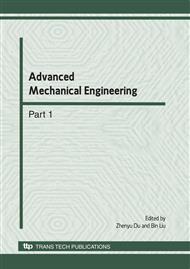[1]
Z. Peng, N. J. Kessissoglou, and M. Cox: A study of the effect of contaminant particles in lubricants using wear debris and vibration condition monitoring techniques, Wear, Vol. 258 (2005), pp.1651-1662.
DOI: 10.1016/j.wear.2004.11.020
Google Scholar
[2]
Z. Peng and N. Kessissoglou: An integrated approach to fault diagnosis of machinery using wear debris and vibration analysis, Wear, Vol. 255 (2003) 1221-1232.
DOI: 10.1016/s0043-1648(03)00098-x
Google Scholar
[3]
J. Gao, P. Zhang, B. Liu, et al.: An Integrated Fault Diagnosis Method of Gearboxes Using Oil Analysis and Vibration Analysis, in: Proceedings of the 8th International Conference on Electronic Measurement and Instruments, 2007, Xian, CHINA, pp.3371-3374.
DOI: 10.1109/icemi.2007.4350932
Google Scholar
[4]
H. Yu, Q. Guo, J. Hu, et al.: Hybrid PSO based wavelet neural networks for intelligent fault diagnosis. Springer LNCS, Vol. 4221 (2007), pp.321-330.
Google Scholar
[5]
Z. Kıral and H. Karagülle: Vibration analysis of rolling element bearings with various defects under the action of an unbalanced force, Mechanical Systems and Signal Processing, Vol. 20 (2006), p.1967-(1991).
DOI: 10.1016/j.ymssp.2005.05.001
Google Scholar
[6]
Y. Yu, D. Yu and J. Cheng: A roller bearing fault diagnosis method based on EMD energy entropy and ANN, Journal of sound and vibration, Vol. 294 (2006), pp.269-277.
DOI: 10.1016/j.jsv.2005.11.002
Google Scholar
[7]
Z. Peng, P. Tse and F. Chu: A comparison study of improved Hilbert-Huang transform and wavelet transform: Application to fault diagnosis for rolling bearing, Mechanical Systems and Signal Processing, Vol. 19 (2005), pp.974-988.
DOI: 10.1016/j.ymssp.2004.01.006
Google Scholar
[8]
T. Chee, I. Phil, and M. David: A comparative experimental study on the diagnostic and prognostic capabilities of acoustics emission, vibration and spectrometric oil analysis for spur gears, Mechanical Systems and Signal Processing, Vol. 21 (2007).
DOI: 10.1016/j.ymssp.2005.09.015
Google Scholar
[9]
J. Mathew and J. S. Stecki: Comparison of vibration and direct reading ferrographic techniques in application to high-speed gears operating under steady and varying load conditions, Journal of the Society of Tribologists and Lubrication Engineers, Vol. 43 (1987).
Google Scholar
[10]
H. Maxwell and B. Johnson: Vibration and lube oil analysis in an integrated predictive maintenance program, in: Proceedings of the 21st Annual Meeting of the Vibration Institute, 1997, USA, pp.117-124.
Google Scholar
[11]
T. Akagaki, M. Nakamur, T. Monzen, and M. Kawabata: Analysis of the behaviour of rolling bearings in contaminated oil using some condition monitoring techniques, Proc. IMechE Part J: J. Engineering Tribology, Vol. 220 (2006), pp.447-453.
DOI: 10.1243/13506501j00605
Google Scholar
[12]
M. M. Maru, R. S. Castillo, and L. R. Padovese: Study of solid contamination in ball bearings through vibration and wear analyses, Tribology International, Vol. 40 (2007), pp.433-440.
DOI: 10.1016/j.triboint.2006.04.007
Google Scholar
[13]
H. Ishigami, T. Fukuda, T. Shibata, and F. Arai: Structure optimization of fuzzy neural network by genetic algorithm, Fuzzy Sets and Systems, Vol. 71 (1995), pp.257-264.
DOI: 10.1016/0165-0114(94)00283-d
Google Scholar
[14]
H. Kuo and H. Chang: A new symbiotic evolution-based fuzzy-neural approach to fault diagnosis of marine propulsion systems, Engineering Applications of Artificial Intelligence, Vol. 17 (2004), pp.919-930.
DOI: 10.1016/j.engappai.2004.08.009
Google Scholar


